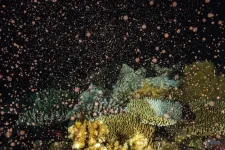(Press-News.org) Nearly a quarter of Portuguese adults have allergies that cause a runny nose. This respiratory disease, formally called allergic rhinitis and frequently associated with asthma, is a common problem around the world, and the upper airway is a key target for research into the underlying disease processes. Now a global team of researchers has discovered that patients with allergy-induced sniffles and asthma have different fungal colonies or mycobiomes in their noses, suggesting potential lines of enquiry for future treatments.
“We showed that allergic rhinitis samples displayed a significantly higher fungal diversity and a different fungal community structure compared to those of healthy controls,” said Dr Luís Delgado of the University of Porto, Portugal, one of the authors of the article in Frontiers in Microbiology. “This may suggest that allergic rhinitis increases the diversity and changes the composition of the upper airway’s microbiome.”
A miniature mycological world
Allergic rhinitis causes sneezing, itching, inflamed nasal mucous membranes, and a blocked and runny nose. It’s often comorbid with asthma, which also involves inflammation and obstructed airways. Allergic rhinitis and asthma may even be different aspects of the same airway inflammatory disease, which makes it critical to identify the links between them and the underlying causes.
To study the nasal mycobiome, the researchers recruited 214 participants from among children and young adults attending an immunology and asthma clinic in Porto. 155 patients had both allergic rhinitis and asthma, while 47 were only diagnosed with allergic rhinitis and 12 with asthma. 125 healthy controls were also enrolled.
The scientists took samples from the participants’ noses using nasal swabs and sequenced the fungal DNA they found, focusing on two specific regions to identify different fungal species and develop an overview of each participant’s mycobiome. After quality controls, they had 306 samples to work with.
They then used network analysis to understand the relationships between different genera of fungi, and to characterize the different communities of fungi present in healthy and sick participants. They also investigated the function of different fungi, looking at the metabolic pathways they affect, to try to understand the implications of any mycobiome variation between the groups of patients.
Coughs and sneezes
The most common families of fungi across all samples were Ascomycota and Basidiomycota. In these two families, 14 genera dominated the mycobiomes.
“Among these dominant genera we detected common fungi that have been recognized in humans as allergenic or opportunistic pathogenic fungi,” said Delgado. “This suggests that the nasal cavity is a major reservoir for fungi that could be involved in allergic rhinitis and asthma.”
There was a very clear and statistically significant difference between the patients with respiratory diseases and the healthy controls – and no significant difference between the different groups of patients with respiratory diseases. The patients with respiratory diseases had more diverse and richer mycobiomes. The fungi sampled from patients with both allergic rhinitis and asthma also showed more evidence of connections between them than the fungi in the healthy participants’ noses and those who only had allergic rhinitis. This could indicate that the fungi are affecting the nose’s immune environment.
The scientists also found that three metabolic pathways associated with the production of a building block for DNA and RNA — 5-aminoimidazole ribonucleotide or AIR — were overabundant in the mycobiome of patients with allergic rhinitis and asthma. AIR is linked to purine production, necessary for energy metabolism and DNA synthesis. If further studies confirm this link and identify the exact problem, AIR could be a future therapeutic target for treatment or diagnosis.
“However, we could not control all patient-specific variables, such as disease severity and related treatment levels, and patients were sampled at a single time,” Delgado cautioned, explaining that the study’s cross-sectional design gives a broad picture, but doesn’t show how the mycobiome changes over time. Longitudinal studies might give a better idea of whether fungi drive disease processes, and if so which fungi are responsible.
“Addressing some of these clinical variables would be interesting follow-ups of our study, if we could get the appropriate funding,” said Delgado. “If we cannot go further at this stage, the key data and hypothesis are published here for others to replicate, and to finally link the laboratory bench to the clinic.”
END
Patients whose allergies cause the sniffles have different fungi living in their noses, compared to healthy people
Scientists investigated the noses of people with asthma and allergic rhinitis and found that the fungi in their noses are different to healthy people, suggesting future targets for treatments
2024-12-17
ELSE PRESS RELEASES FROM THIS DATE:
The psychological implications of Big Brother’s gaze
2024-12-17
A new psychological study has shown that when people know they are under surveillance it generates an automatic response of heightened awareness of being watched, with implications for public mental health.
In a paper published in the journal Neuroscience of Consciousness psychology researchers from the University of Technology Sydney (UTS) worked with 54 participants to examine the effects of surveillance on an essential function of human sensory perception – the ability to detect another person’s gaze.
Lead author, Associate Professor of neuroscience and behaviour Kiley Seymour, said previous research has established the effects on conscious behaviour when people know they ...
Sylvester Cancer Tip Sheet for Dec. 2024
2024-12-17
DECEMBER 2024 TIP SHEET: A behavioral expert offers advice for dealing with loss and holiday grief, a physician-scientist explains using “biological age” as a tool to predict early colorectal cancer risk, a cancer leader receives a prestigious award for mentorship, blood cancer experts share research insights that may eventually lead to a cure for multiple myeloma, a recent study shows genetic mutations accumulate in smokers with MDS, two clinical trials show promise for using an antibody to treat high-risk forms of lymphoma and ongoing research seeks answers for higher breast cancer ...
Up to $47 million award supports collaborative eye transplant research co-led by USC
2024-12-17
A federal funding agency that supports high-impact research capable of driving biomedical and health breakthroughs has awarded up to $47 million for a project aimed at moving eye transplants to restore vision closer to reality. The six-year award from the Advanced Research Projects Agency for Health (ARPA-H) Transplantation of Human Eye Allografts (THEA) program is intended to supercharge an interdisciplinary effort to bring eye transplantation forward to clinical trial.
To date, only one whole-eye transplant has ever been successfully ...
Corals depend on near neighbours to reproduce
2024-12-17
A new study reveals corals must be within only a few metres of each other to successfully reproduce, leaving them vulnerable in a warming world.
The international research, led by The University of Queensland’s Professor Peter Mumby, measured the success of a natural spawning event in March this year.
“In what came as a surprise, we saw that corals needed to be within 10 metres of one another, and preferably closer than that for fertilisation to take place,” Professor Mumby said.
“We knew corals couldn’t be too ...
Most coastal Arctic infrastructure faces instability by 2100
2024-12-17
Researcher contacts:
Annett Bartsch, b.geos GmbH, annett.bartsch@bgeos.com (UTC+1 hour)
Rodrigue Tanguy, b.geos GmbH, rodrigue.tanguy@bgeos.com (UTC+1 hour)
AGU press contact:
Rebecca Dzombak, news@agu.org (UTC-5 hours)
WASHINGTON — A new study has produced the first map of all coastal communities and infrastructure across the Arctic, showing the vulnerability of the built environment to threats from climate change. Erosion is currently the biggest threat to Arctic coastlines; some places are already experiencing ...
$10.8 million grant supports cutting-edge leukemia research
2024-12-17
Continuing its role as a leader in leukemia research, Washington University School of Medicine in St. Louis has been awarded a five-year, $10.8 million grant to further its exceptional programs in leukemia and other blood cancers.
The grant, from the National Cancer Institute (NCI) of the National Institutes of Health (NIH), renews funding for a prestigious Specialized Program of Research Excellence (SPORE) in leukemia. The NCI’s SPORE program is designed to support translational research that moves discoveries from the lab to the clinic. The WashU Medicine leukemia SPORE is one of only two SPOREs in leukemia in the country.
Siteman Cancer Center, ...
Alzheimer’s disease deaths lowest among taxi and ambulance drivers
2024-12-17
Taxi drivers and ambulance drivers, whose jobs require frequent spatial and navigational processing, have the lowest levels of death due to Alzheimer’s disease compared with other occupations, finds a study in the Christmas issue of The BMJ.
The findings are observational, so can’t confirm a direct link, but the researchers say they raise the possibility that memory intensive driving occupations, such as taxi and ambulance driving, might be associated with some protection against Alzheimer’s disease.
The hippocampus ...
Disney princesses face hidden health risks, warn experts
2024-12-17
Although Disney princesses seem to live happily ever after, they face serious real world health hazards, warn experts in the Christmas issue of The BMJ.
Sanne van Dijk and colleagues call on Disney to consider strategies such as mindfulness and personal protection measures to improve princesses’ wellbeing and help them start living healthily ever after.
Snow White is the “fairest princess of all” yet as a scullery maid for her wicked stepmother, opportunities for social interaction are extremely limited, putting her at risk of cardiovascular disease, depression, anxiety, and early death, explain the authors.
Fortunately, Snow White meets the Seven ...
Coaching trainees just before a procedure could improve patient safety
2024-12-17
Giving inexperienced clinicians a quick coaching session with an expert just before they carry out a procedure boosts their success rate and could improve patient safety, finds a study in the Christmas issue of The BMJ.
Athletes and musicians often rehearse, warm up, or practice just before they are about to perform. Yet in medicine, where performing a procedure can have life-altering consequences, warm-up, or “just-in-time” training is rare to non-existent.
To fill this knowledge gap, a team of US researchers conducted a randomised clinical trial to assess whether coaching inexperienced clinicians just before intubating an infant (inserting ...
Mass General Brigham study finds lower rates of death from Alzheimer’s disease among taxi and ambulance drivers
2024-12-17
A new study raises the possibility that jobs that require frequent spatial processing—such as figuring out a taxi route or the best way to navigate to a hospital—could lead to lower rates of death from Alzheimer’s disease. Researchers from Mass General Brigham investigated this possibility by using national data on the occupations of people who had died to evaluate risk of death from Alzheimer’s disease across 443 professions. They found that taxi driving and ambulance driving were associated with a lower rate of death from Alzheimer’s disease compared to other professions. Results ...
LAST 30 PRESS RELEASES:
COVID-19 leaves a lasting mark on the human brain
Scientists use ultrasound to soften and treat cancer tumors without damaging healthy tissue
Community swimming program for Black youth boosts skills, sense of belonging, study finds
Specific depressive symptoms in midlife linked to increased dementia risk
An ‘illuminating’ design sheds light on cholesterol
Who is more likely to get long COVID?
Study showcases resilience and rapid growth of “living rocks”
Naval Research Lab diver earns Office of Naval Research 2025 Sailor of the Year
New Mayo-led study establishes practical definition for rapidly progressive dementia
Fossil fuel industry’s “climate false solutions” reinforce its power and aggravate environmental injustice
Researchers reveal bias in a widely used measure of algorithm performance
Alcohol causes cancer. A study from IOCB Prague confirms damage to DNA and shows how cells defend against it
Hidden viruses in wastewater treatment may shape public health risks, study finds
Unlock the power of nature: how biomass can transform climate mitigation
Biochar reshapes hidden soil microbes that capture carbon dioxide in farmland
Reducing saturated fat intake shows mortality benefit, but only in high-risk individuals
Manta rays create mobile ecosystems, study finds
Study: Mixed results in using lipoic acid to treat progressive multiple sclerosis
Norbert Holtkamp appointed director of Fermi National Accelerator Laboratory
New agentic AI platform accelerates advanced optics design
Biologists discover neurons use physical signals — not electricity — to stabilize communication
Researchers discover that a hormone can access the brain by hitchhiking
University of Oklahoma researcher awarded funding to pursue AI-powered material design
Exploring how the visual system recovers following injury
Support for parents with infants at pediatric check-ups leads to better reading and math skills in elementary school
Kids’ behavioral health is a growing share of family health costs
Day & night: Cancer disrupts the brain’s natural rhythm
COVID-19 vaccination significantly reduces risk to pregnant women and baby
The role of vaccination in maternal and perinatal outcomes associated with COVID-19 in pregnancy
Mayo Clinic smartwatch system helps parents shorten and defuse children's severe tantrums early
[Press-News.org] Patients whose allergies cause the sniffles have different fungi living in their noses, compared to healthy peopleScientists investigated the noses of people with asthma and allergic rhinitis and found that the fungi in their noses are different to healthy people, suggesting future targets for treatments


